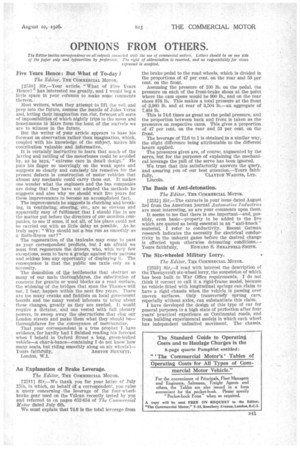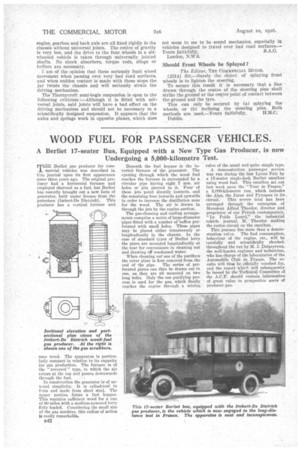OPINIONS FROM OTHERS.
Page 25

Page 26

If you've noticed an error in this article please click here to report it so we can fix it.
The Editor invites correspondence on all subjects coatnecied with the use of commercial motors. Letters should be on one side of the paper only and typewritten by preference, The right of abbreviation is reserved, and no responsibility for views
expressed is accepted,
Five Years Hence : But What of To-day ?
• The Editor, THE COMMERCIAL MOTOR,
[2510] Sir,—Your article "What of Five Years Hence?" has interested me greatly, and I would beg a little space in your columns to make some comments thereon.; • Most writers, when they attempt to lift the veil and peep into the future, assume the mantle of Jules Verne and, letting their imagination run riot, forecast all sorts of impossibilities of which nightly trips to the moon and honeymoons in Mars form the least of. the marvels we are to witness in the future.
But the writer of your article .appears to base his forecast on observation rather than imagination, which, coupled with his knowledge of the subject, makes his contribution valuable and informative.,
It is certainly instructive to learn that much of the jarring and rattling of the motorbuses could be avoided by, as he 'says, extreme care in detail design." He puts his finger so unerringly on the weak spots and suggests so clearly and concisely his remedies for the present defects in construction of motor vehicles that almost any mechanic could carry them out. It makes one wonder what the engineers and the bus companies are doing that they have not adopted the methods he suggests and also why we should wait five years for these improvements to become an accomplished fact.
The improvements he suggests in clutching and breaking, in ventilating, steering, etc., are so obvious and apparently easy of fulfilment that I should like to see the matter put before the directors of our omnibus companies, to see if some, if not all, of his plans could not be carried out with as little delay as passible. As he truly says: "Why should not a bus run as smoothly as a Rolls-Royce car?"
The regeneration of the taxicabs may come to pass as your correspondent predicts, but I ana afraid we must first regenerate the drivers, who, with very few exceptions, seem to have a grudge against their patrons and seldom lose any opportunity of displaying it. The consequence is that the public use taxis only as a necessity.
The demolition of the bottlenecks that obstruct so many of our main thoroughfares, the substitution of concrete for granite or wood blocks as a road surface, the widening of the bridges that span the Thames will not, I fear, happen within the next five years. There are too many cranks and faddists on local government boards and too many vested interests to' bring about these changes, greatly as they are needed. It would require a dictator, and one vested with full plenary powers, to sweep away the obstructions that clog our London streets and make them what they should he— thoroughfares for the conveyance of merchandize.
That your correspondent is a true prophet I have evidence, for hardly had I finished reading his forecast when I beheld in Oxford Street a long, green-bodied vehicle—a char-k-bancs—containing I do not know how many seats, but riding smoothly along on six wheels 1—
Yours faithfully, ASHTON BENNETT. London, W.1.
An Explanation of Brake Leverage.
The Editor, THE COMMERCIAL MOTOR.
[2511] Sir,—We thank you for your letter of July 15th, in which, on behalf ot a correspondent, you raise a query concerning the leverage of the four-wheelbrake gear used on the Vulcan recently tested by you and referred to: on pages 652-654 of The Commercial Motor dated July 6th.
We must explain that 74.6 is the total leverage from the brake pedal to the road wheels, which is divided in the proportions of 47 per cent, on the rear and 53 per cent. on the front.
Assuming the pressure of 100 lb. on the pedal, the pressure on each of the front-brake shoes at the point where the cam opens would be 990 lb., and on the rear shoes 876 lb. This makes a total pressure at the front of 3,960 lb. and at rear of 3,504 lb.—an aggregate of 7,464 lb.
This is 74.6 times as great as the pedal pressure, and the proportion between back and front is taken as the pressures on respective cams. This gives a proportion of 47 per cent, on the rear and 53 per cent. on the front.
The leverage of 72.6 to 1 is obtained in a similar way, the slight difference being attributable to the different levers applied.
The pressures given are, of course, augmented by the servo, but for the purposes of explaining the mechanical leverage the pun of the servo has been ignored.
We trust that this satisfactorily answers the query, and assuring you of our best attention.—Yours CLAYTON WAGONS, LTD.
Lincoln.
The Basis of Anti-detonation.
The Editor, THE COMMERCIAL MOTOR.
[25121 Sir,—The extracts in your issue dated August 3rd from the American journal Automotive Industries are most interesting, as are your comments upon them.
It seems to me that there is one important—and, possibly, even basic—property to be added to the five which are quoted as being essential in an " anti-knock " material. I refer to conductivity. Recent German research indicates the necessity for electrical conductivity in the unburat gades before the desired change is effected upon otherwise detonating conditions.- Yours faithfully, EDWARD S. SHRAENELL-SMITH.
The Six-wheeled Military Lorry. • The Editor, THE COMMERCIAL MOTOR.
[2513] Sir,—I read with interest the description of the. Thornycroft six-wheel lorry, the suspension of which has been built to War Office requirements. I do not think it correct to call it a rigid-frame model, because no vehicle fitted with longitudinal springs can claim to have a rigid chassis when the vehicle is passing over uneven surfaces. Only transversely sprung cars, especially without axles, can substantiate this claim. I have developed the design of this type of car for general purposes to a high state of perfection after four years' practical experience on Continental roads, and from building experimental models in which each wheel has independent unlimited movement. The chassis, engine, gearbox and back axle are all fixed rigidly in the chassis without universal joints. The centre of gravity is very low, and the drive to the four wheels in a sixwheeled vehicle is taken through universally jointed shafts. No shock absorbers, torque rods, slings or buffers are necessary.
I am of the opinion that these seriously limit wheel movement when passing over very bad road surfaces, and when sudden contact is made with these stops the jar twists the chassis and will seriously strain the driving mechanism.
The Thornycroft semi-bogie suspension is open to the following criticism :—Although it is fitted with uni, versal joints, said joints will have a bad effect on the driving mechanism and should not be necessary in a scientifically designed suspension. It appears that the axles and springs work in opposite planes, which does not seem to me to be sound mechanics, especially in vehicles designed to travel over bad road surfaces.— Yours faithfully, R.A.G. London, N.W.6.
Should Front Wheels be Splayed ?
The Editor, THE COMMERCIAL MOTOR.
[2511] Sir,—Surely the object of splaying front wheels is to lighten the steering. To secure this result it is necessary that a line drawn through the centre of the steering pins shall strike the ground at the centre point of contact between the ground and the tyre. This can only be secured by (a) splaying the wheels, or (b) inclining the steering pins. Both
methods are used.—Yours faithfully, H.M.C. ,Dublin.




























